Management Perspectives: Self-Assessment and SWOT Analysis Report
VerifiedAdded on 2021/11/22
|11
|3146
|103
Report
AI Summary
This assignment, completed by an MBA student at Torrens University, provides a comprehensive self-assessment focusing on management perspectives. The report delves into the student's skills and behaviors through the use of self-assessment tools such as Myers-Briggs, Emotional Intelligence Test, and VIA Character Strengths Survey. A detailed SWOT analysis highlights strengths like being a good team player and self-awareness, while identifying weaknesses such as perfectionism and difficulty making decisions for others. The analysis explores opportunities for growth, including enhancing leadership skills and addressing weaknesses to improve organizational fit. Threats include the student's strong values and commitment to goals. The report also discusses the importance of diversity and concludes with an examination of how the student's characteristics align with organizational needs.
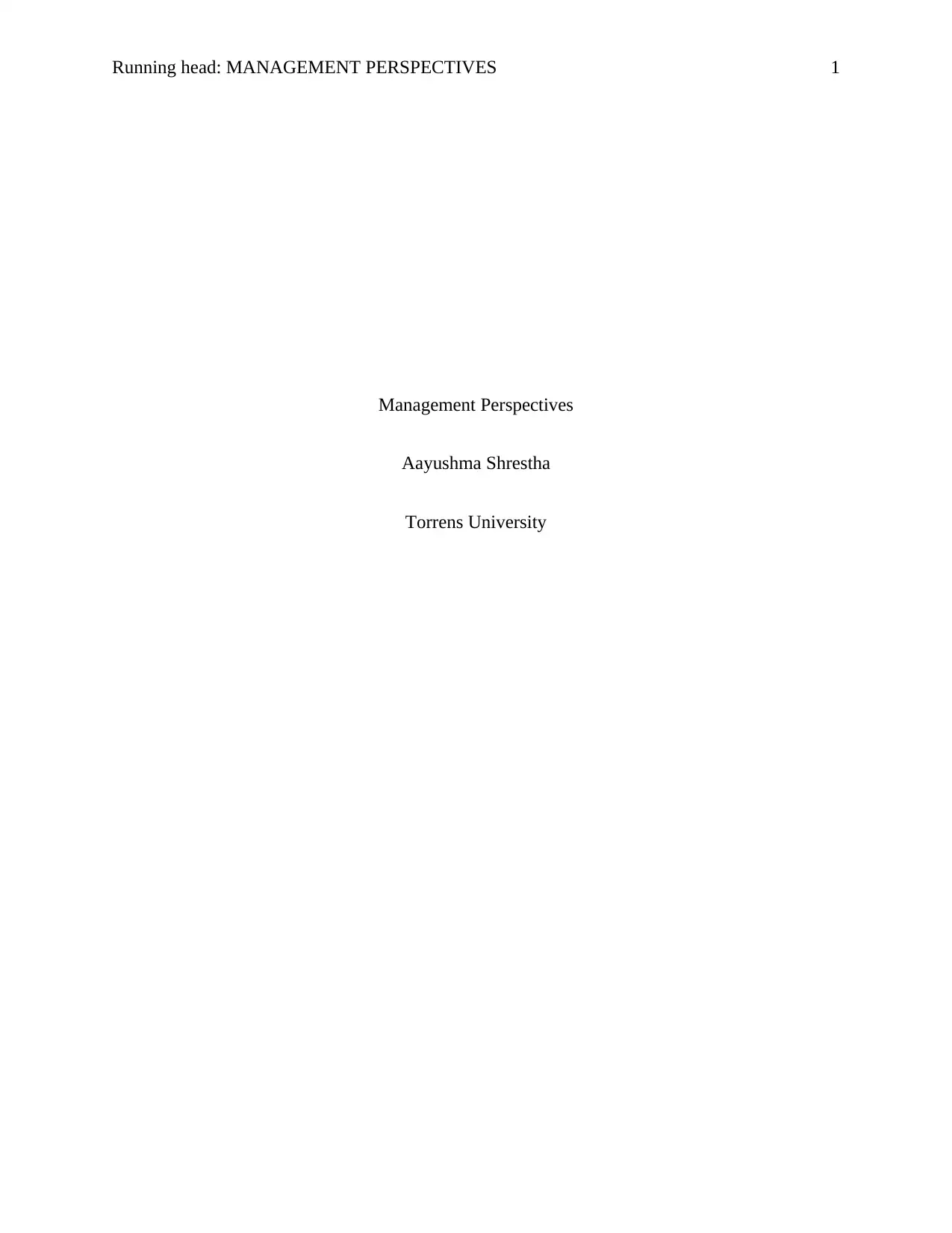
Running head: MANAGEMENT PERSPECTIVES 1
Management Perspectives
Aayushma Shrestha
Torrens University
Management Perspectives
Aayushma Shrestha
Torrens University
Paraphrase This Document
Need a fresh take? Get an instant paraphrase of this document with our AI Paraphraser
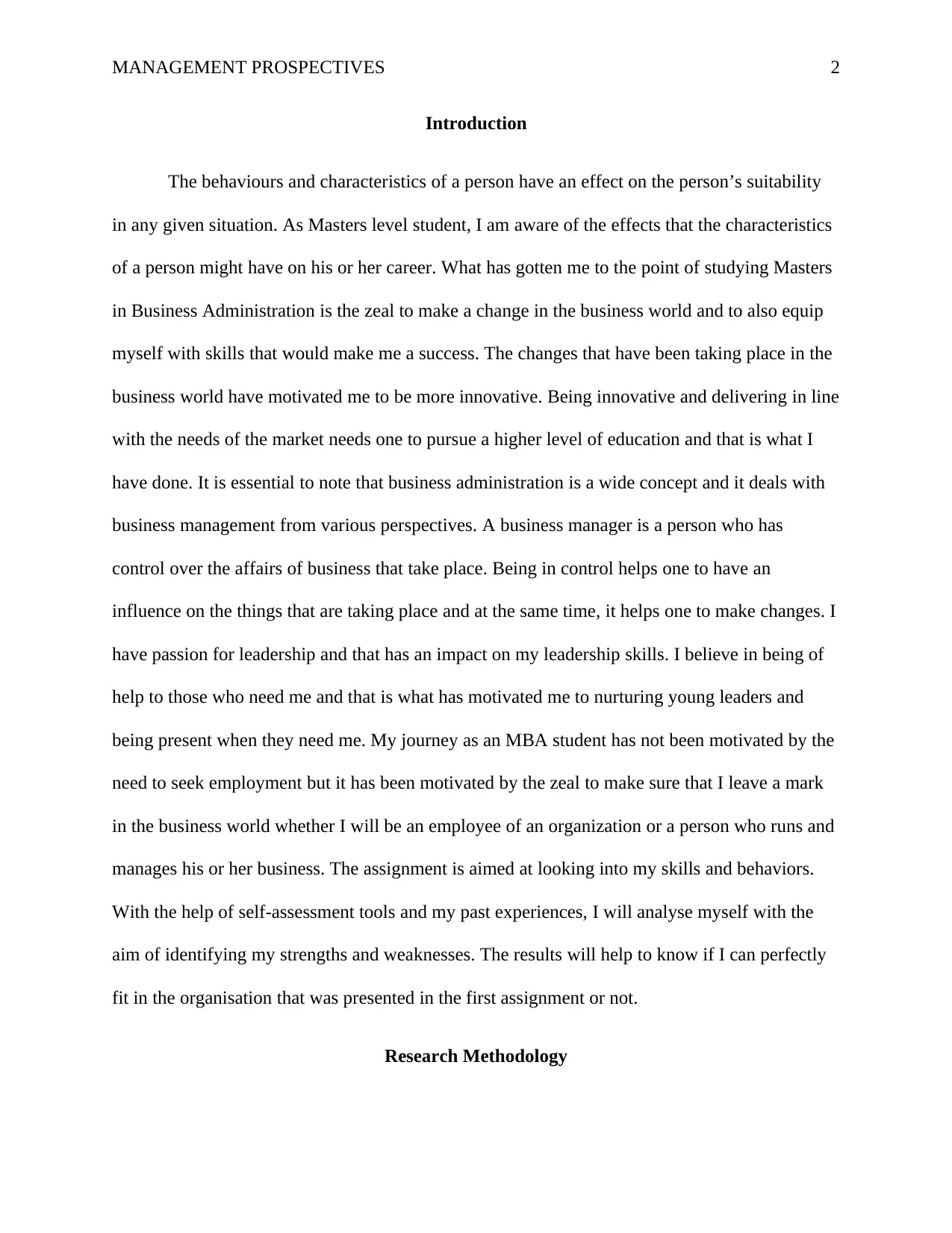
MANAGEMENT PROSPECTIVES 2
Introduction
The behaviours and characteristics of a person have an effect on the person’s suitability
in any given situation. As Masters level student, I am aware of the effects that the characteristics
of a person might have on his or her career. What has gotten me to the point of studying Masters
in Business Administration is the zeal to make a change in the business world and to also equip
myself with skills that would make me a success. The changes that have been taking place in the
business world have motivated me to be more innovative. Being innovative and delivering in line
with the needs of the market needs one to pursue a higher level of education and that is what I
have done. It is essential to note that business administration is a wide concept and it deals with
business management from various perspectives. A business manager is a person who has
control over the affairs of business that take place. Being in control helps one to have an
influence on the things that are taking place and at the same time, it helps one to make changes. I
have passion for leadership and that has an impact on my leadership skills. I believe in being of
help to those who need me and that is what has motivated me to nurturing young leaders and
being present when they need me. My journey as an MBA student has not been motivated by the
need to seek employment but it has been motivated by the zeal to make sure that I leave a mark
in the business world whether I will be an employee of an organization or a person who runs and
manages his or her business. The assignment is aimed at looking into my skills and behaviors.
With the help of self-assessment tools and my past experiences, I will analyse myself with the
aim of identifying my strengths and weaknesses. The results will help to know if I can perfectly
fit in the organisation that was presented in the first assignment or not.
Research Methodology
Introduction
The behaviours and characteristics of a person have an effect on the person’s suitability
in any given situation. As Masters level student, I am aware of the effects that the characteristics
of a person might have on his or her career. What has gotten me to the point of studying Masters
in Business Administration is the zeal to make a change in the business world and to also equip
myself with skills that would make me a success. The changes that have been taking place in the
business world have motivated me to be more innovative. Being innovative and delivering in line
with the needs of the market needs one to pursue a higher level of education and that is what I
have done. It is essential to note that business administration is a wide concept and it deals with
business management from various perspectives. A business manager is a person who has
control over the affairs of business that take place. Being in control helps one to have an
influence on the things that are taking place and at the same time, it helps one to make changes. I
have passion for leadership and that has an impact on my leadership skills. I believe in being of
help to those who need me and that is what has motivated me to nurturing young leaders and
being present when they need me. My journey as an MBA student has not been motivated by the
need to seek employment but it has been motivated by the zeal to make sure that I leave a mark
in the business world whether I will be an employee of an organization or a person who runs and
manages his or her business. The assignment is aimed at looking into my skills and behaviors.
With the help of self-assessment tools and my past experiences, I will analyse myself with the
aim of identifying my strengths and weaknesses. The results will help to know if I can perfectly
fit in the organisation that was presented in the first assignment or not.
Research Methodology
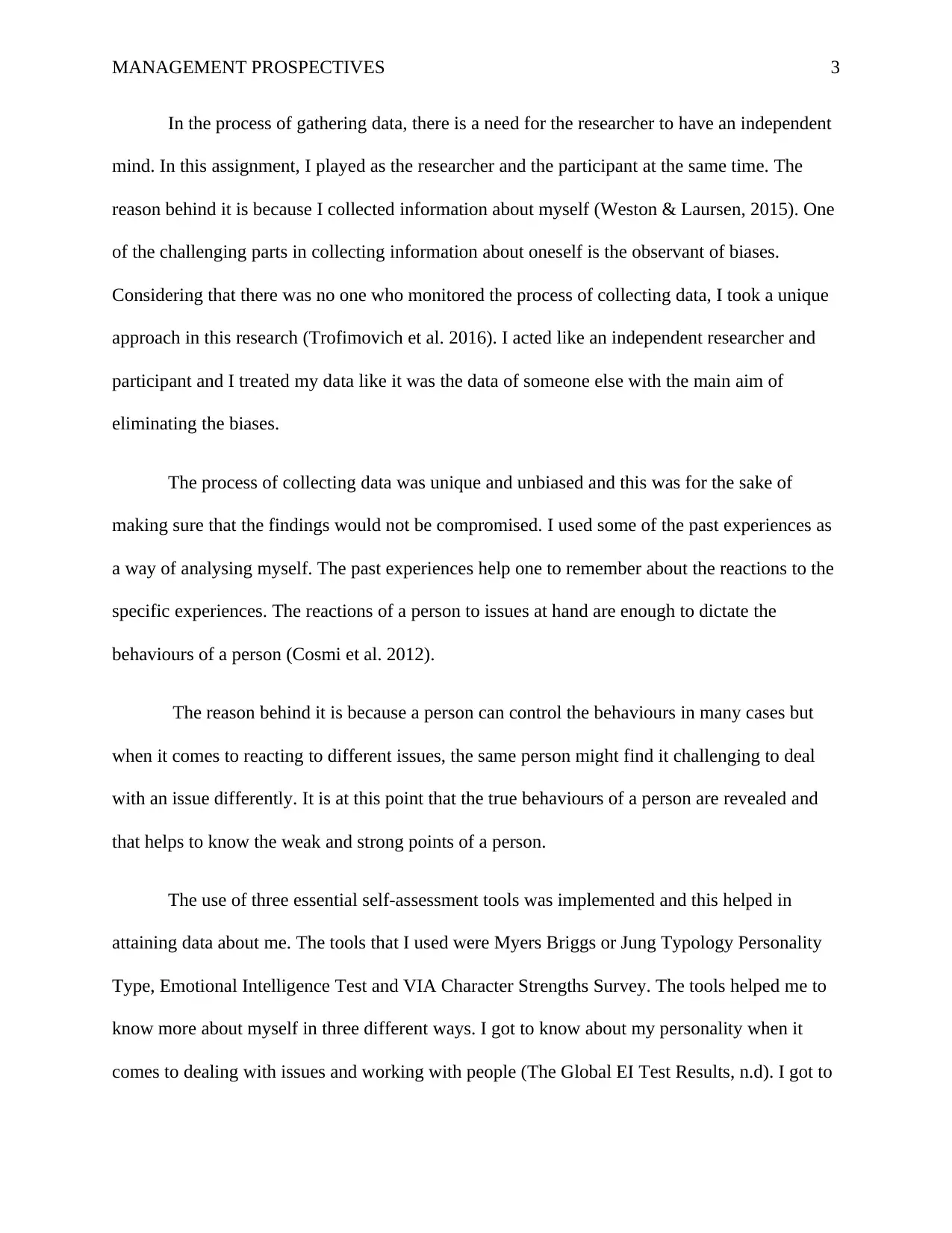
MANAGEMENT PROSPECTIVES 3
In the process of gathering data, there is a need for the researcher to have an independent
mind. In this assignment, I played as the researcher and the participant at the same time. The
reason behind it is because I collected information about myself (Weston & Laursen, 2015). One
of the challenging parts in collecting information about oneself is the observant of biases.
Considering that there was no one who monitored the process of collecting data, I took a unique
approach in this research (Trofimovich et al. 2016). I acted like an independent researcher and
participant and I treated my data like it was the data of someone else with the main aim of
eliminating the biases.
The process of collecting data was unique and unbiased and this was for the sake of
making sure that the findings would not be compromised. I used some of the past experiences as
a way of analysing myself. The past experiences help one to remember about the reactions to the
specific experiences. The reactions of a person to issues at hand are enough to dictate the
behaviours of a person (Cosmi et al. 2012).
The reason behind it is because a person can control the behaviours in many cases but
when it comes to reacting to different issues, the same person might find it challenging to deal
with an issue differently. It is at this point that the true behaviours of a person are revealed and
that helps to know the weak and strong points of a person.
The use of three essential self-assessment tools was implemented and this helped in
attaining data about me. The tools that I used were Myers Briggs or Jung Typology Personality
Type, Emotional Intelligence Test and VIA Character Strengths Survey. The tools helped me to
know more about myself in three different ways. I got to know about my personality when it
comes to dealing with issues and working with people (The Global EI Test Results, n.d). I got to
In the process of gathering data, there is a need for the researcher to have an independent
mind. In this assignment, I played as the researcher and the participant at the same time. The
reason behind it is because I collected information about myself (Weston & Laursen, 2015). One
of the challenging parts in collecting information about oneself is the observant of biases.
Considering that there was no one who monitored the process of collecting data, I took a unique
approach in this research (Trofimovich et al. 2016). I acted like an independent researcher and
participant and I treated my data like it was the data of someone else with the main aim of
eliminating the biases.
The process of collecting data was unique and unbiased and this was for the sake of
making sure that the findings would not be compromised. I used some of the past experiences as
a way of analysing myself. The past experiences help one to remember about the reactions to the
specific experiences. The reactions of a person to issues at hand are enough to dictate the
behaviours of a person (Cosmi et al. 2012).
The reason behind it is because a person can control the behaviours in many cases but
when it comes to reacting to different issues, the same person might find it challenging to deal
with an issue differently. It is at this point that the true behaviours of a person are revealed and
that helps to know the weak and strong points of a person.
The use of three essential self-assessment tools was implemented and this helped in
attaining data about me. The tools that I used were Myers Briggs or Jung Typology Personality
Type, Emotional Intelligence Test and VIA Character Strengths Survey. The tools helped me to
know more about myself in three different ways. I got to know about my personality when it
comes to dealing with issues and working with people (The Global EI Test Results, n.d). I got to
⊘ This is a preview!⊘
Do you want full access?
Subscribe today to unlock all pages.

Trusted by 1+ million students worldwide
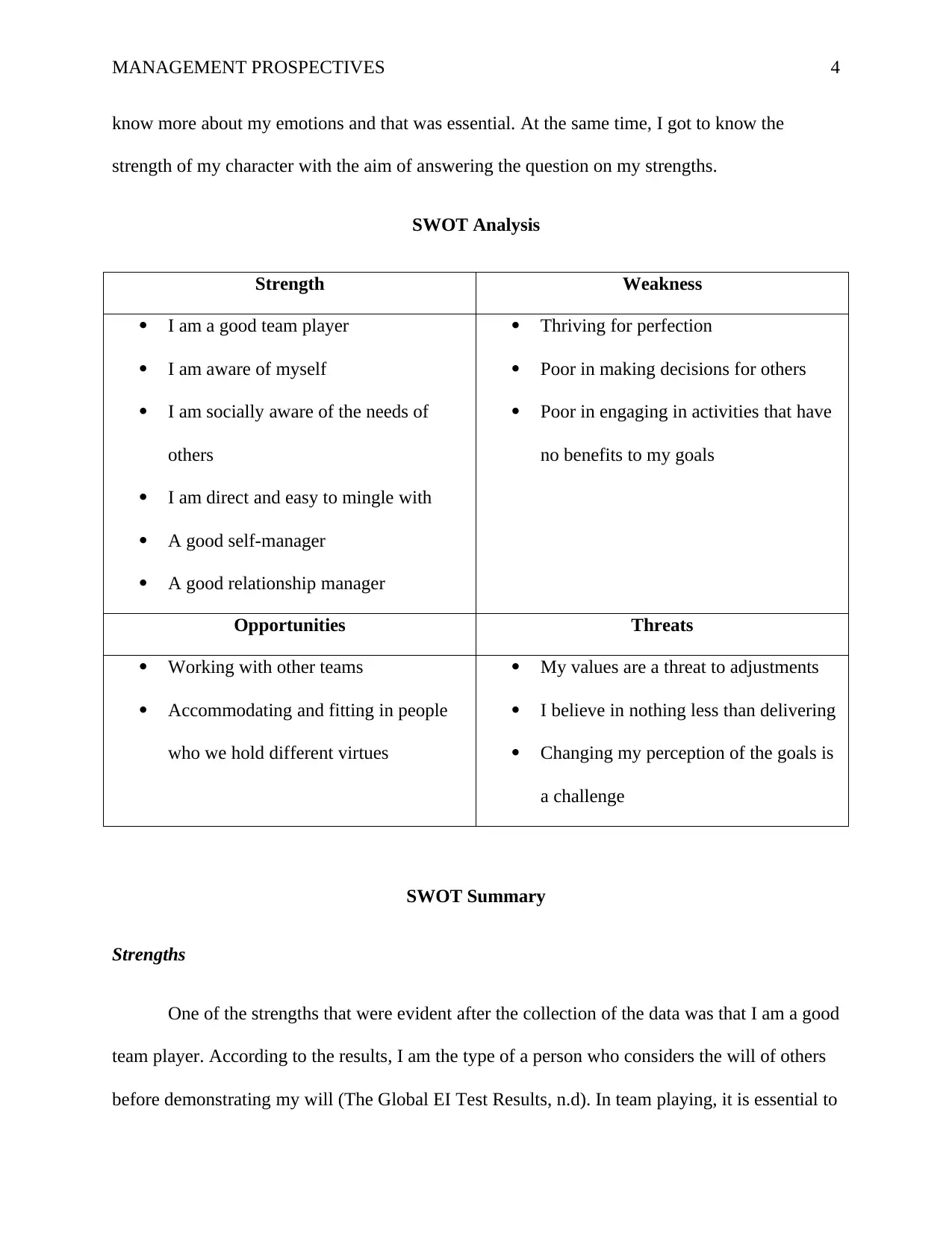
MANAGEMENT PROSPECTIVES 4
know more about my emotions and that was essential. At the same time, I got to know the
strength of my character with the aim of answering the question on my strengths.
SWOT Analysis
Strength Weakness
I am a good team player
I am aware of myself
I am socially aware of the needs of
others
I am direct and easy to mingle with
A good self-manager
A good relationship manager
Thriving for perfection
Poor in making decisions for others
Poor in engaging in activities that have
no benefits to my goals
Opportunities Threats
Working with other teams
Accommodating and fitting in people
who we hold different virtues
My values are a threat to adjustments
I believe in nothing less than delivering
Changing my perception of the goals is
a challenge
SWOT Summary
Strengths
One of the strengths that were evident after the collection of the data was that I am a good
team player. According to the results, I am the type of a person who considers the will of others
before demonstrating my will (The Global EI Test Results, n.d). In team playing, it is essential to
know more about my emotions and that was essential. At the same time, I got to know the
strength of my character with the aim of answering the question on my strengths.
SWOT Analysis
Strength Weakness
I am a good team player
I am aware of myself
I am socially aware of the needs of
others
I am direct and easy to mingle with
A good self-manager
A good relationship manager
Thriving for perfection
Poor in making decisions for others
Poor in engaging in activities that have
no benefits to my goals
Opportunities Threats
Working with other teams
Accommodating and fitting in people
who we hold different virtues
My values are a threat to adjustments
I believe in nothing less than delivering
Changing my perception of the goals is
a challenge
SWOT Summary
Strengths
One of the strengths that were evident after the collection of the data was that I am a good
team player. According to the results, I am the type of a person who considers the will of others
before demonstrating my will (The Global EI Test Results, n.d). In team playing, it is essential to
Paraphrase This Document
Need a fresh take? Get an instant paraphrase of this document with our AI Paraphraser
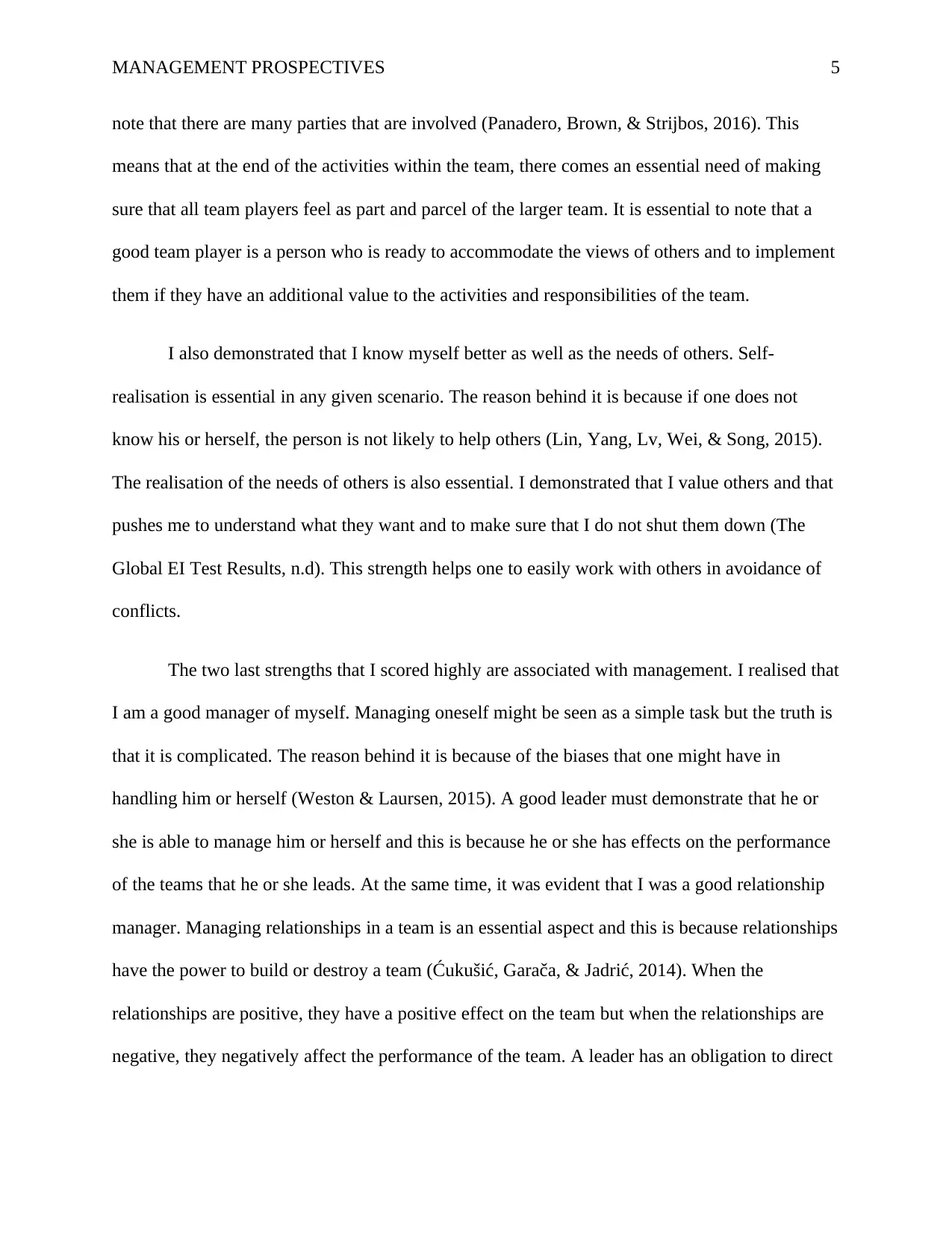
MANAGEMENT PROSPECTIVES 5
note that there are many parties that are involved (Panadero, Brown, & Strijbos, 2016). This
means that at the end of the activities within the team, there comes an essential need of making
sure that all team players feel as part and parcel of the larger team. It is essential to note that a
good team player is a person who is ready to accommodate the views of others and to implement
them if they have an additional value to the activities and responsibilities of the team.
I also demonstrated that I know myself better as well as the needs of others. Self-
realisation is essential in any given scenario. The reason behind it is because if one does not
know his or herself, the person is not likely to help others (Lin, Yang, Lv, Wei, & Song, 2015).
The realisation of the needs of others is also essential. I demonstrated that I value others and that
pushes me to understand what they want and to make sure that I do not shut them down (The
Global EI Test Results, n.d). This strength helps one to easily work with others in avoidance of
conflicts.
The two last strengths that I scored highly are associated with management. I realised that
I am a good manager of myself. Managing oneself might be seen as a simple task but the truth is
that it is complicated. The reason behind it is because of the biases that one might have in
handling him or herself (Weston & Laursen, 2015). A good leader must demonstrate that he or
she is able to manage him or herself and this is because he or she has effects on the performance
of the teams that he or she leads. At the same time, it was evident that I was a good relationship
manager. Managing relationships in a team is an essential aspect and this is because relationships
have the power to build or destroy a team (Ćukušić, Garača, & Jadrić, 2014). When the
relationships are positive, they have a positive effect on the team but when the relationships are
negative, they negatively affect the performance of the team. A leader has an obligation to direct
note that there are many parties that are involved (Panadero, Brown, & Strijbos, 2016). This
means that at the end of the activities within the team, there comes an essential need of making
sure that all team players feel as part and parcel of the larger team. It is essential to note that a
good team player is a person who is ready to accommodate the views of others and to implement
them if they have an additional value to the activities and responsibilities of the team.
I also demonstrated that I know myself better as well as the needs of others. Self-
realisation is essential in any given scenario. The reason behind it is because if one does not
know his or herself, the person is not likely to help others (Lin, Yang, Lv, Wei, & Song, 2015).
The realisation of the needs of others is also essential. I demonstrated that I value others and that
pushes me to understand what they want and to make sure that I do not shut them down (The
Global EI Test Results, n.d). This strength helps one to easily work with others in avoidance of
conflicts.
The two last strengths that I scored highly are associated with management. I realised that
I am a good manager of myself. Managing oneself might be seen as a simple task but the truth is
that it is complicated. The reason behind it is because of the biases that one might have in
handling him or herself (Weston & Laursen, 2015). A good leader must demonstrate that he or
she is able to manage him or herself and this is because he or she has effects on the performance
of the teams that he or she leads. At the same time, it was evident that I was a good relationship
manager. Managing relationships in a team is an essential aspect and this is because relationships
have the power to build or destroy a team (Ćukušić, Garača, & Jadrić, 2014). When the
relationships are positive, they have a positive effect on the team but when the relationships are
negative, they negatively affect the performance of the team. A leader has an obligation to direct
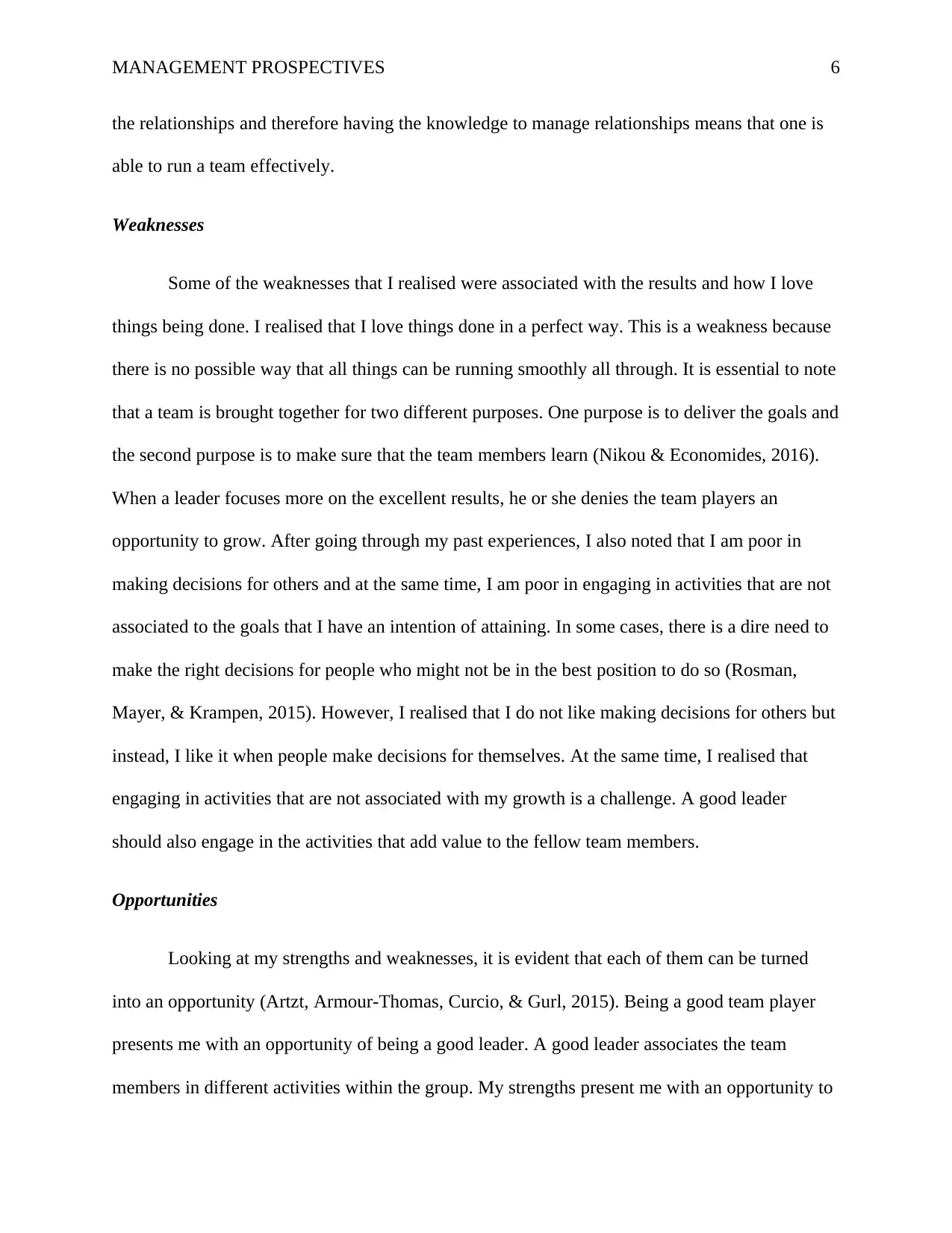
MANAGEMENT PROSPECTIVES 6
the relationships and therefore having the knowledge to manage relationships means that one is
able to run a team effectively.
Weaknesses
Some of the weaknesses that I realised were associated with the results and how I love
things being done. I realised that I love things done in a perfect way. This is a weakness because
there is no possible way that all things can be running smoothly all through. It is essential to note
that a team is brought together for two different purposes. One purpose is to deliver the goals and
the second purpose is to make sure that the team members learn (Nikou & Economides, 2016).
When a leader focuses more on the excellent results, he or she denies the team players an
opportunity to grow. After going through my past experiences, I also noted that I am poor in
making decisions for others and at the same time, I am poor in engaging in activities that are not
associated to the goals that I have an intention of attaining. In some cases, there is a dire need to
make the right decisions for people who might not be in the best position to do so (Rosman,
Mayer, & Krampen, 2015). However, I realised that I do not like making decisions for others but
instead, I like it when people make decisions for themselves. At the same time, I realised that
engaging in activities that are not associated with my growth is a challenge. A good leader
should also engage in the activities that add value to the fellow team members.
Opportunities
Looking at my strengths and weaknesses, it is evident that each of them can be turned
into an opportunity (Artzt, Armour-Thomas, Curcio, & Gurl, 2015). Being a good team player
presents me with an opportunity of being a good leader. A good leader associates the team
members in different activities within the group. My strengths present me with an opportunity to
the relationships and therefore having the knowledge to manage relationships means that one is
able to run a team effectively.
Weaknesses
Some of the weaknesses that I realised were associated with the results and how I love
things being done. I realised that I love things done in a perfect way. This is a weakness because
there is no possible way that all things can be running smoothly all through. It is essential to note
that a team is brought together for two different purposes. One purpose is to deliver the goals and
the second purpose is to make sure that the team members learn (Nikou & Economides, 2016).
When a leader focuses more on the excellent results, he or she denies the team players an
opportunity to grow. After going through my past experiences, I also noted that I am poor in
making decisions for others and at the same time, I am poor in engaging in activities that are not
associated to the goals that I have an intention of attaining. In some cases, there is a dire need to
make the right decisions for people who might not be in the best position to do so (Rosman,
Mayer, & Krampen, 2015). However, I realised that I do not like making decisions for others but
instead, I like it when people make decisions for themselves. At the same time, I realised that
engaging in activities that are not associated with my growth is a challenge. A good leader
should also engage in the activities that add value to the fellow team members.
Opportunities
Looking at my strengths and weaknesses, it is evident that each of them can be turned
into an opportunity (Artzt, Armour-Thomas, Curcio, & Gurl, 2015). Being a good team player
presents me with an opportunity of being a good leader. A good leader associates the team
members in different activities within the group. My strengths present me with an opportunity to
⊘ This is a preview!⊘
Do you want full access?
Subscribe today to unlock all pages.

Trusted by 1+ million students worldwide
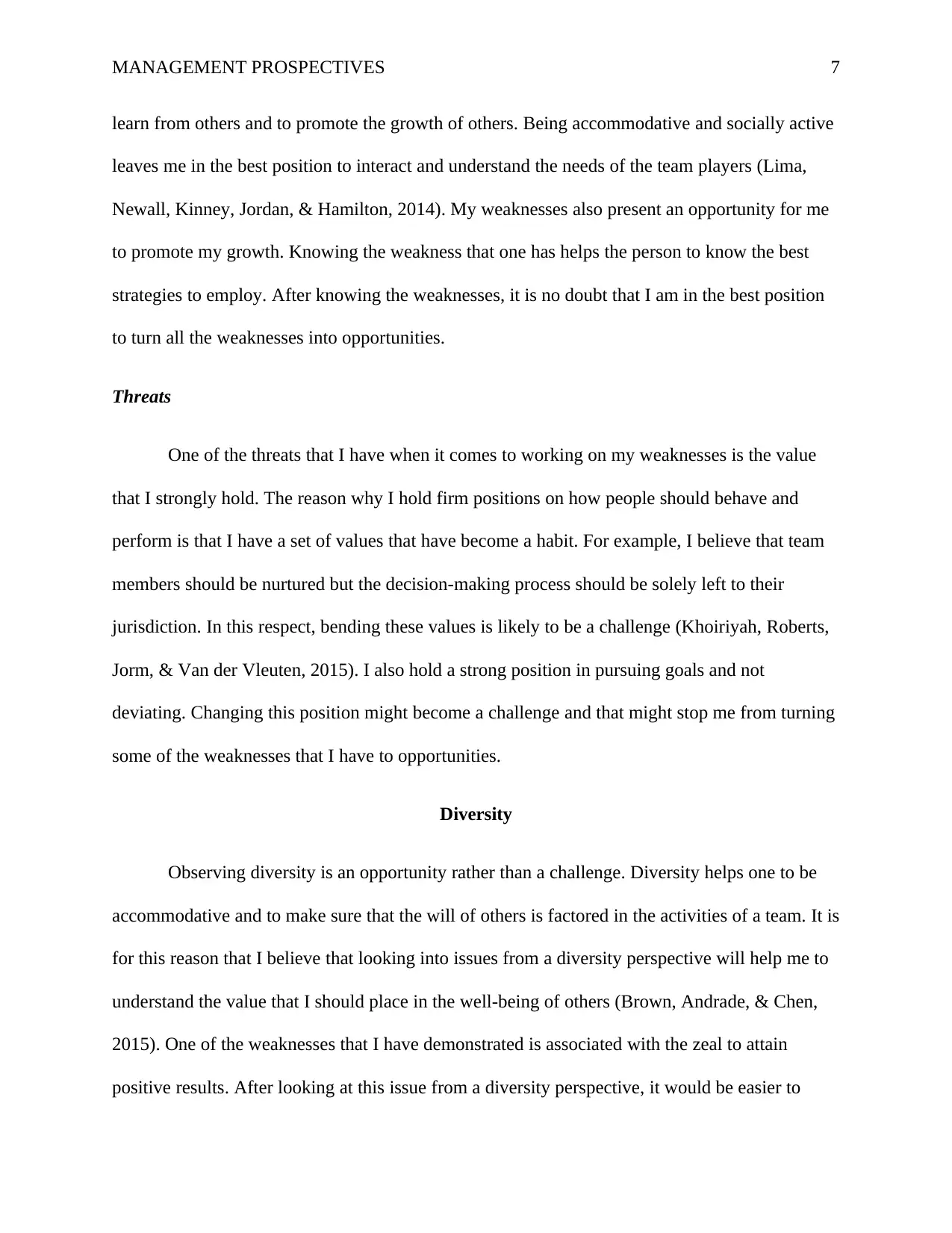
MANAGEMENT PROSPECTIVES 7
learn from others and to promote the growth of others. Being accommodative and socially active
leaves me in the best position to interact and understand the needs of the team players (Lima,
Newall, Kinney, Jordan, & Hamilton, 2014). My weaknesses also present an opportunity for me
to promote my growth. Knowing the weakness that one has helps the person to know the best
strategies to employ. After knowing the weaknesses, it is no doubt that I am in the best position
to turn all the weaknesses into opportunities.
Threats
One of the threats that I have when it comes to working on my weaknesses is the value
that I strongly hold. The reason why I hold firm positions on how people should behave and
perform is that I have a set of values that have become a habit. For example, I believe that team
members should be nurtured but the decision-making process should be solely left to their
jurisdiction. In this respect, bending these values is likely to be a challenge (Khoiriyah, Roberts,
Jorm, & Van der Vleuten, 2015). I also hold a strong position in pursuing goals and not
deviating. Changing this position might become a challenge and that might stop me from turning
some of the weaknesses that I have to opportunities.
Diversity
Observing diversity is an opportunity rather than a challenge. Diversity helps one to be
accommodative and to make sure that the will of others is factored in the activities of a team. It is
for this reason that I believe that looking into issues from a diversity perspective will help me to
understand the value that I should place in the well-being of others (Brown, Andrade, & Chen,
2015). One of the weaknesses that I have demonstrated is associated with the zeal to attain
positive results. After looking at this issue from a diversity perspective, it would be easier to
learn from others and to promote the growth of others. Being accommodative and socially active
leaves me in the best position to interact and understand the needs of the team players (Lima,
Newall, Kinney, Jordan, & Hamilton, 2014). My weaknesses also present an opportunity for me
to promote my growth. Knowing the weakness that one has helps the person to know the best
strategies to employ. After knowing the weaknesses, it is no doubt that I am in the best position
to turn all the weaknesses into opportunities.
Threats
One of the threats that I have when it comes to working on my weaknesses is the value
that I strongly hold. The reason why I hold firm positions on how people should behave and
perform is that I have a set of values that have become a habit. For example, I believe that team
members should be nurtured but the decision-making process should be solely left to their
jurisdiction. In this respect, bending these values is likely to be a challenge (Khoiriyah, Roberts,
Jorm, & Van der Vleuten, 2015). I also hold a strong position in pursuing goals and not
deviating. Changing this position might become a challenge and that might stop me from turning
some of the weaknesses that I have to opportunities.
Diversity
Observing diversity is an opportunity rather than a challenge. Diversity helps one to be
accommodative and to make sure that the will of others is factored in the activities of a team. It is
for this reason that I believe that looking into issues from a diversity perspective will help me to
understand the value that I should place in the well-being of others (Brown, Andrade, & Chen,
2015). One of the weaknesses that I have demonstrated is associated with the zeal to attain
positive results. After looking at this issue from a diversity perspective, it would be easier to
Paraphrase This Document
Need a fresh take? Get an instant paraphrase of this document with our AI Paraphraser
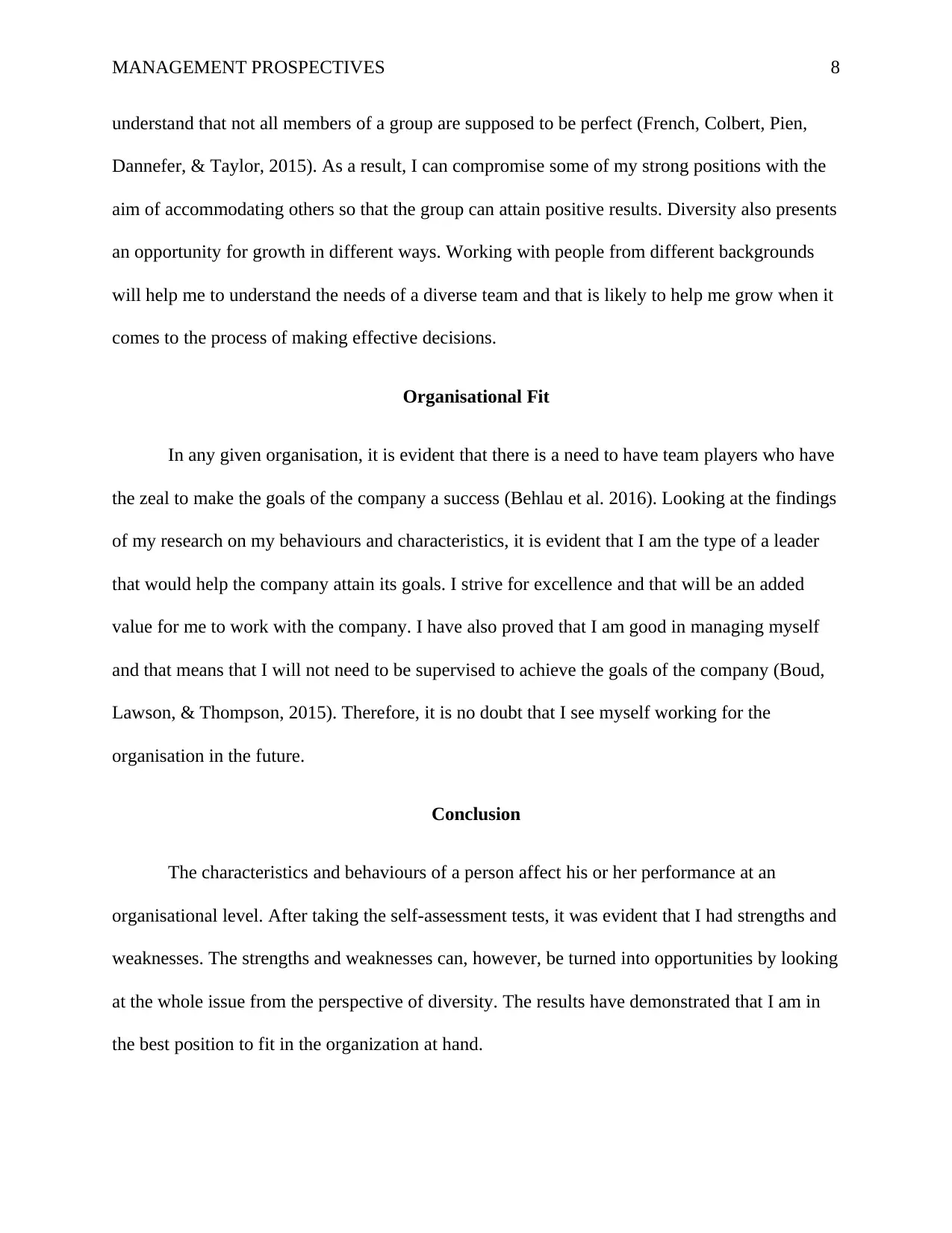
MANAGEMENT PROSPECTIVES 8
understand that not all members of a group are supposed to be perfect (French, Colbert, Pien,
Dannefer, & Taylor, 2015). As a result, I can compromise some of my strong positions with the
aim of accommodating others so that the group can attain positive results. Diversity also presents
an opportunity for growth in different ways. Working with people from different backgrounds
will help me to understand the needs of a diverse team and that is likely to help me grow when it
comes to the process of making effective decisions.
Organisational Fit
In any given organisation, it is evident that there is a need to have team players who have
the zeal to make the goals of the company a success (Behlau et al. 2016). Looking at the findings
of my research on my behaviours and characteristics, it is evident that I am the type of a leader
that would help the company attain its goals. I strive for excellence and that will be an added
value for me to work with the company. I have also proved that I am good in managing myself
and that means that I will not need to be supervised to achieve the goals of the company (Boud,
Lawson, & Thompson, 2015). Therefore, it is no doubt that I see myself working for the
organisation in the future.
Conclusion
The characteristics and behaviours of a person affect his or her performance at an
organisational level. After taking the self-assessment tests, it was evident that I had strengths and
weaknesses. The strengths and weaknesses can, however, be turned into opportunities by looking
at the whole issue from the perspective of diversity. The results have demonstrated that I am in
the best position to fit in the organization at hand.
understand that not all members of a group are supposed to be perfect (French, Colbert, Pien,
Dannefer, & Taylor, 2015). As a result, I can compromise some of my strong positions with the
aim of accommodating others so that the group can attain positive results. Diversity also presents
an opportunity for growth in different ways. Working with people from different backgrounds
will help me to understand the needs of a diverse team and that is likely to help me grow when it
comes to the process of making effective decisions.
Organisational Fit
In any given organisation, it is evident that there is a need to have team players who have
the zeal to make the goals of the company a success (Behlau et al. 2016). Looking at the findings
of my research on my behaviours and characteristics, it is evident that I am the type of a leader
that would help the company attain its goals. I strive for excellence and that will be an added
value for me to work with the company. I have also proved that I am good in managing myself
and that means that I will not need to be supervised to achieve the goals of the company (Boud,
Lawson, & Thompson, 2015). Therefore, it is no doubt that I see myself working for the
organisation in the future.
Conclusion
The characteristics and behaviours of a person affect his or her performance at an
organisational level. After taking the self-assessment tests, it was evident that I had strengths and
weaknesses. The strengths and weaknesses can, however, be turned into opportunities by looking
at the whole issue from the perspective of diversity. The results have demonstrated that I am in
the best position to fit in the organization at hand.
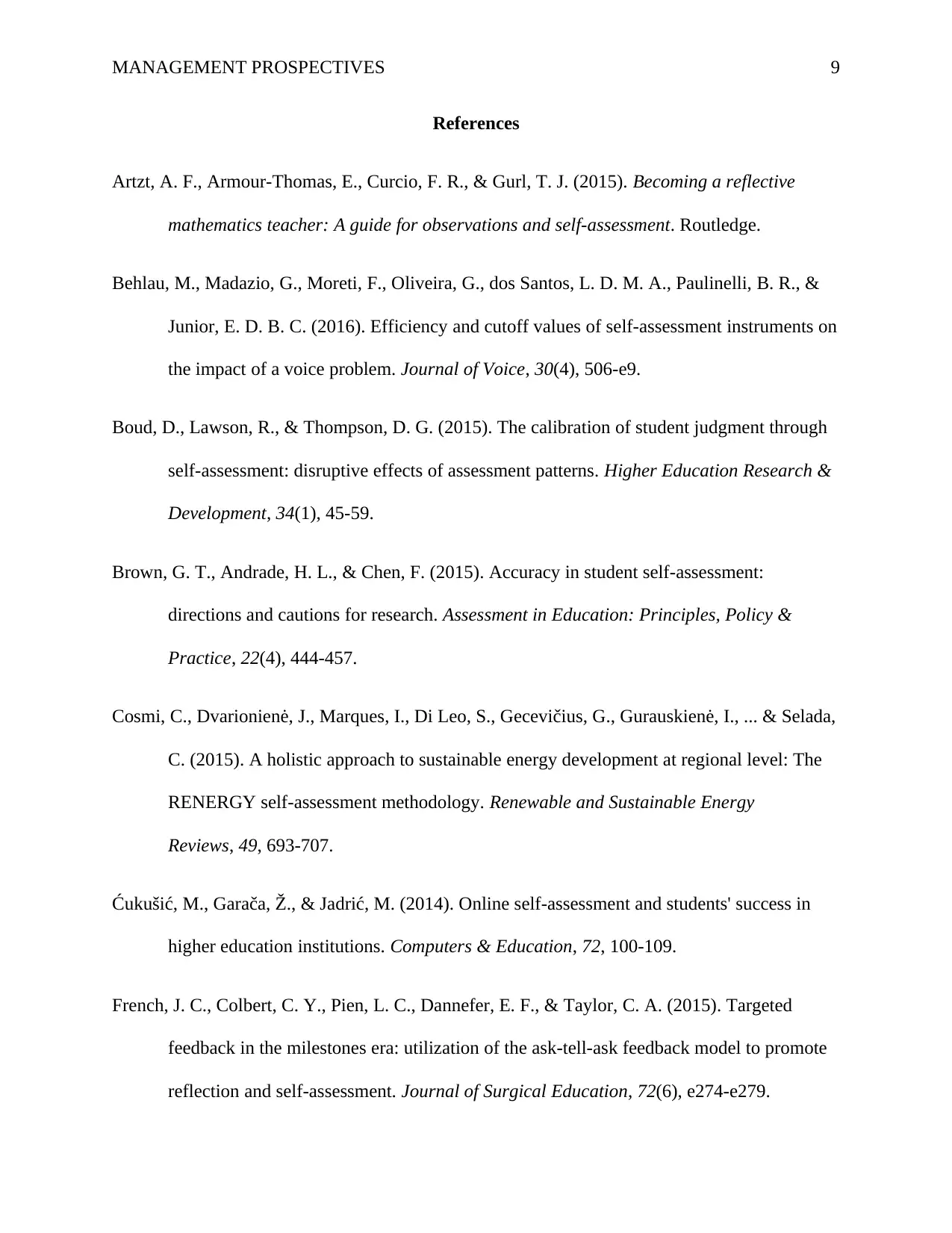
MANAGEMENT PROSPECTIVES 9
References
Artzt, A. F., Armour-Thomas, E., Curcio, F. R., & Gurl, T. J. (2015). Becoming a reflective
mathematics teacher: A guide for observations and self-assessment. Routledge.
Behlau, M., Madazio, G., Moreti, F., Oliveira, G., dos Santos, L. D. M. A., Paulinelli, B. R., &
Junior, E. D. B. C. (2016). Efficiency and cutoff values of self-assessment instruments on
the impact of a voice problem. Journal of Voice, 30(4), 506-e9.
Boud, D., Lawson, R., & Thompson, D. G. (2015). The calibration of student judgment through
self-assessment: disruptive effects of assessment patterns. Higher Education Research &
Development, 34(1), 45-59.
Brown, G. T., Andrade, H. L., & Chen, F. (2015). Accuracy in student self-assessment:
directions and cautions for research. Assessment in Education: Principles, Policy &
Practice, 22(4), 444-457.
Cosmi, C., Dvarionienė, J., Marques, I., Di Leo, S., Gecevičius, G., Gurauskienė, I., ... & Selada,
C. (2015). A holistic approach to sustainable energy development at regional level: The
RENERGY self-assessment methodology. Renewable and Sustainable Energy
Reviews, 49, 693-707.
Ćukušić, M., Garača, Ž., & Jadrić, M. (2014). Online self-assessment and students' success in
higher education institutions. Computers & Education, 72, 100-109.
French, J. C., Colbert, C. Y., Pien, L. C., Dannefer, E. F., & Taylor, C. A. (2015). Targeted
feedback in the milestones era: utilization of the ask-tell-ask feedback model to promote
reflection and self-assessment. Journal of Surgical Education, 72(6), e274-e279.
References
Artzt, A. F., Armour-Thomas, E., Curcio, F. R., & Gurl, T. J. (2015). Becoming a reflective
mathematics teacher: A guide for observations and self-assessment. Routledge.
Behlau, M., Madazio, G., Moreti, F., Oliveira, G., dos Santos, L. D. M. A., Paulinelli, B. R., &
Junior, E. D. B. C. (2016). Efficiency and cutoff values of self-assessment instruments on
the impact of a voice problem. Journal of Voice, 30(4), 506-e9.
Boud, D., Lawson, R., & Thompson, D. G. (2015). The calibration of student judgment through
self-assessment: disruptive effects of assessment patterns. Higher Education Research &
Development, 34(1), 45-59.
Brown, G. T., Andrade, H. L., & Chen, F. (2015). Accuracy in student self-assessment:
directions and cautions for research. Assessment in Education: Principles, Policy &
Practice, 22(4), 444-457.
Cosmi, C., Dvarionienė, J., Marques, I., Di Leo, S., Gecevičius, G., Gurauskienė, I., ... & Selada,
C. (2015). A holistic approach to sustainable energy development at regional level: The
RENERGY self-assessment methodology. Renewable and Sustainable Energy
Reviews, 49, 693-707.
Ćukušić, M., Garača, Ž., & Jadrić, M. (2014). Online self-assessment and students' success in
higher education institutions. Computers & Education, 72, 100-109.
French, J. C., Colbert, C. Y., Pien, L. C., Dannefer, E. F., & Taylor, C. A. (2015). Targeted
feedback in the milestones era: utilization of the ask-tell-ask feedback model to promote
reflection and self-assessment. Journal of Surgical Education, 72(6), e274-e279.
⊘ This is a preview!⊘
Do you want full access?
Subscribe today to unlock all pages.

Trusted by 1+ million students worldwide
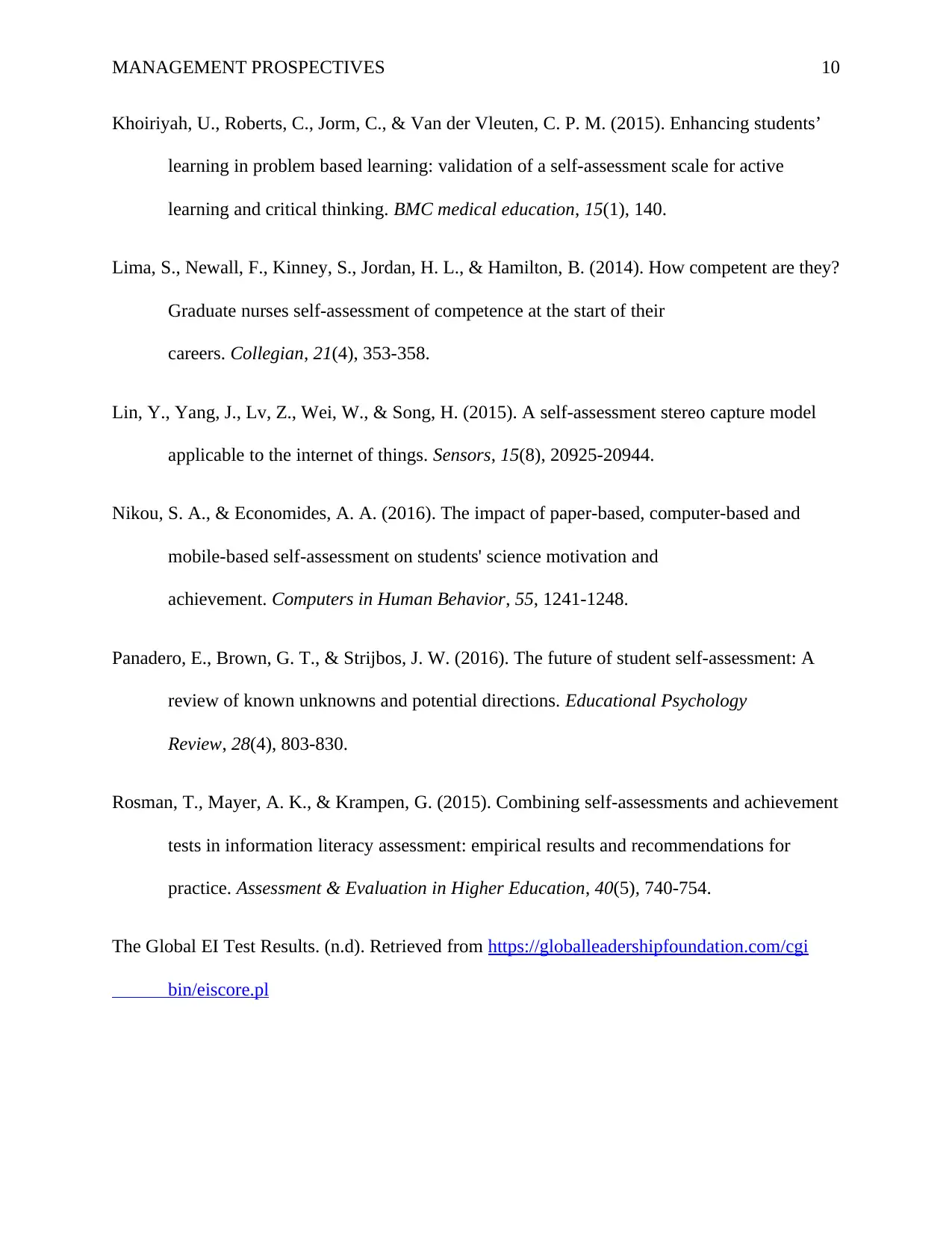
MANAGEMENT PROSPECTIVES 10
Khoiriyah, U., Roberts, C., Jorm, C., & Van der Vleuten, C. P. M. (2015). Enhancing students’
learning in problem based learning: validation of a self-assessment scale for active
learning and critical thinking. BMC medical education, 15(1), 140.
Lima, S., Newall, F., Kinney, S., Jordan, H. L., & Hamilton, B. (2014). How competent are they?
Graduate nurses self-assessment of competence at the start of their
careers. Collegian, 21(4), 353-358.
Lin, Y., Yang, J., Lv, Z., Wei, W., & Song, H. (2015). A self-assessment stereo capture model
applicable to the internet of things. Sensors, 15(8), 20925-20944.
Nikou, S. A., & Economides, A. A. (2016). The impact of paper-based, computer-based and
mobile-based self-assessment on students' science motivation and
achievement. Computers in Human Behavior, 55, 1241-1248.
Panadero, E., Brown, G. T., & Strijbos, J. W. (2016). The future of student self-assessment: A
review of known unknowns and potential directions. Educational Psychology
Review, 28(4), 803-830.
Rosman, T., Mayer, A. K., & Krampen, G. (2015). Combining self-assessments and achievement
tests in information literacy assessment: empirical results and recommendations for
practice. Assessment & Evaluation in Higher Education, 40(5), 740-754.
The Global EI Test Results. (n.d). Retrieved from https://globalleadershipfoundation.com/cgi
bin/eiscore.pl
Khoiriyah, U., Roberts, C., Jorm, C., & Van der Vleuten, C. P. M. (2015). Enhancing students’
learning in problem based learning: validation of a self-assessment scale for active
learning and critical thinking. BMC medical education, 15(1), 140.
Lima, S., Newall, F., Kinney, S., Jordan, H. L., & Hamilton, B. (2014). How competent are they?
Graduate nurses self-assessment of competence at the start of their
careers. Collegian, 21(4), 353-358.
Lin, Y., Yang, J., Lv, Z., Wei, W., & Song, H. (2015). A self-assessment stereo capture model
applicable to the internet of things. Sensors, 15(8), 20925-20944.
Nikou, S. A., & Economides, A. A. (2016). The impact of paper-based, computer-based and
mobile-based self-assessment on students' science motivation and
achievement. Computers in Human Behavior, 55, 1241-1248.
Panadero, E., Brown, G. T., & Strijbos, J. W. (2016). The future of student self-assessment: A
review of known unknowns and potential directions. Educational Psychology
Review, 28(4), 803-830.
Rosman, T., Mayer, A. K., & Krampen, G. (2015). Combining self-assessments and achievement
tests in information literacy assessment: empirical results and recommendations for
practice. Assessment & Evaluation in Higher Education, 40(5), 740-754.
The Global EI Test Results. (n.d). Retrieved from https://globalleadershipfoundation.com/cgi
bin/eiscore.pl
Paraphrase This Document
Need a fresh take? Get an instant paraphrase of this document with our AI Paraphraser
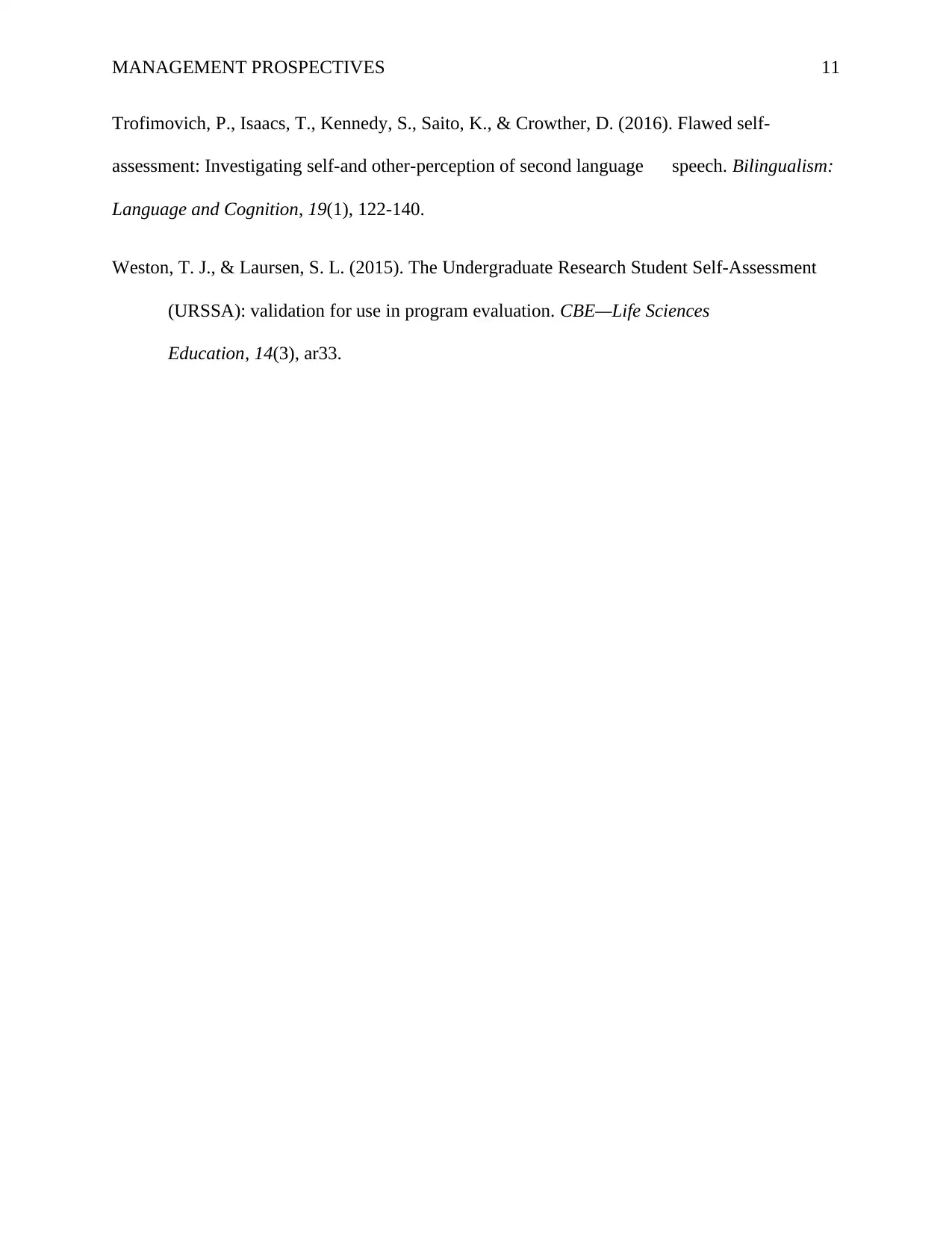
MANAGEMENT PROSPECTIVES 11
Trofimovich, P., Isaacs, T., Kennedy, S., Saito, K., & Crowther, D. (2016). Flawed self-
assessment: Investigating self-and other-perception of second language speech. Bilingualism:
Language and Cognition, 19(1), 122-140.
Weston, T. J., & Laursen, S. L. (2015). The Undergraduate Research Student Self-Assessment
(URSSA): validation for use in program evaluation. CBE—Life Sciences
Education, 14(3), ar33.
Trofimovich, P., Isaacs, T., Kennedy, S., Saito, K., & Crowther, D. (2016). Flawed self-
assessment: Investigating self-and other-perception of second language speech. Bilingualism:
Language and Cognition, 19(1), 122-140.
Weston, T. J., & Laursen, S. L. (2015). The Undergraduate Research Student Self-Assessment
(URSSA): validation for use in program evaluation. CBE—Life Sciences
Education, 14(3), ar33.
1 out of 11
Related Documents
Your All-in-One AI-Powered Toolkit for Academic Success.
+13062052269
info@desklib.com
Available 24*7 on WhatsApp / Email
![[object Object]](/_next/static/media/star-bottom.7253800d.svg)
Unlock your academic potential
Copyright © 2020–2025 A2Z Services. All Rights Reserved. Developed and managed by ZUCOL.



